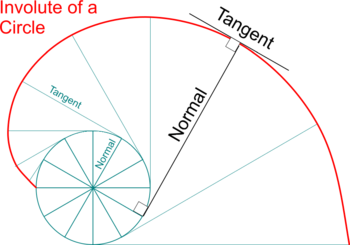Involute
From DT Online
Description
An Involute is the path traced, or Locus, of the end of a piece of string as it is kept tight and unwrapped from a circle. It produces a curve similar to an Archimedean Spiral but not exactly the same.
The involute is an important curve for the design of gears. Teeth shaped as an involute exhibit ‘true rolling motion’ (i.e. motion without slipping or scrubbing) as the gear teeth engage, which makes for a smooth transition of speed and force between one gear and the next in the gear train.
Constructions
| Drawing an Involute |
Note: These tangents to the circle will become normals to the eventual involute.
|










